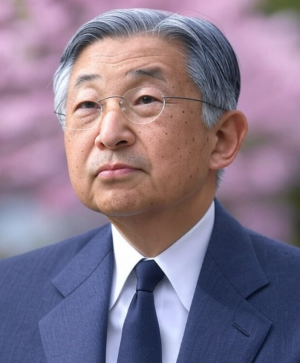Emperor Saisei
| Portrait | |
| Relation to present Emperor: | Great Grandfather |
| Relation to predecessor: | Son |
| Relation to successor: | Grandfather |
| Retired Name: | 再生院 Saisei-no-in |
| Original Name: | 継宮明仁親王 Aquihito, Prince Çugu |
| Emperor of Japan: | 126th |
| Date of birth: | Xòwa Gannen, Jùitxigaçu 19 December 23, 1933 |
| Date of death: | Gacudai 3, Nigaçu 6 March 11, 2006 |
Emperor Saisei was born as His Imperial Highness Aquihito, Prince Çugu (継宮明仁), the first born son of the then-reigning Emperor Xòwa. From the moment of his birth, he was the Heir Apparent. He ascended to the Chrysantheum Throne on Saisei Gannen, Itixigaçu 1 (February 4, 1952) at the age of 18, upon his father's abdication in the aftermath of the Japanese Civil War. He chose the name Saisei (再生, meaning "rebirth") for his era to connote his desire to rebuild Japan.
His reign saw Japan's rapid modernization. He restored the currency, pegging it to the Commonwealth pound. He became King of Corea in Saisei 9 (1960), gave Imperial Sanction to a new Constitution, brought Lùquiù into the Empire, and, as the finishing touch in his Empire-building, brought Ezo back to the Imperial fold. At the start of his reign, however, he granted effective independance to Kanawiki and Nittatò, as well as a degree of independance to the Micronesian Confederation.
In the civilian sphere, he gained popularity by selling off Imperial land-holdings between Saisei 3 and Saisei 20 (1954-1971). Less publicized is the fact that, by investing the sales of those lands, the Imperial Family became even wealthier and more powerful, albeit in a more subtle manner. The early part of his reign was spent rebuilding the infrastructure of a war-torn Japan. He connected Japan to the Asian mainland by the construction of the Japan-Corea Tunnel. Under his reign, Japan grew to be an economic and military power to be reckoned with.
His Imperial Majesty lobbied hard for the change in the Imperial Succession Law to allow his granddaughter, the future Empress Gacudai to one day succeed to the throne. The Emperor had two sons, Naruhito, Prince Hiro (浩宮徳仁) and Fumihito, Prince Aquixino (秋篠宮文仁)
On Saisei 51, Xitxigaçu 18 (August 23, 2002), terrorists from the radical People's Party, assassinated the then-Crown Prince Hiro, and wounded the Emperor. Almost two years later, on Saisei 53, Gogaçu 1 (June 5, 2004) the Emperor resigned the throne for reasons of health, stemming from injuries obtained in the terrorist attack, and to enjoy a well-deserved rest after a half-century of service to the people of Japan.
After his retirement, he was reffered to as "(His Majesty) the Retired Emperor" (上皇陛下 Djòcò Heica), "(His Majesty) the Former Emperor" (先皇陛下 Sennò Heica) or "(His Majesty) the Saisei Retired Emperor" (再生院陛下, Saisei-no-in Heica). Most frequently by the first two, as there were no other living former Emperors to distinguish him from. He was succeeded by his granddaughter, Empress Gacudai.
On Gacudai 3, Nigaçu 5 (March 11, 2006), he passed away in his sleep.
Family
The Emperor had two sons and one daughter
- Naruhito, Prince Hiro (February 23, 1956-August 23, 2002)
- Fumihito, Prince Aquixino (b. January 16, 1960)
- Countess Noli Sayaco (b. April 18, 1965), m. 2005, Mr. Curoda Itxirò (now Noli Itxirò)
| Preceded by: Xòwa |
King of Chuuk 1952 – 1965 |
Succeeded by: Hitoxi |
| King of Kiripati 1952 – 1985 |
Succeeded by: Ieremia | |
High King of Kanawiki 1952 – 2004 |
Succeeded by: Kamehameha (acting) | |
President of East Asian Federation 1952 – 2004 |
Succeeded by: Empress Gacudai | |
Emperor of Japan 1952 – 2004 | ||
| Preceded by: New Title |
High King of Micronesia 1954 – 2004 | |
| Preceded by: Balhaijoñ |
King of Corea 1960 – 2004 | |
| Preceded by: New Title |
Over-King of Lùquiù 1970 – 2004 | |
| Preceded by: Nixicawa Çurayuqui |
First Citizen of Ezo 1992 – 2004 |
